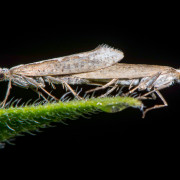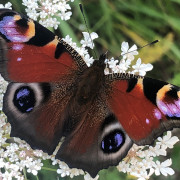- Science News
- Life sciences
- Moths in mud can uncover prehistoric secrets
Moths in mud can uncover prehistoric secrets

Dead Spruce Budworm moths (Choristoneura fumiferana) floating on the surface of a boreal lake during an insect outbreak period in 2017. North of Lake Saint-Jean, Quebec, Canada. Image by: Emy Tremblay, Karoline Pitre, Miguel Montoro Girona, Lionel Navarro, Guillaume Grosbois
Revolutionary new technique for studying lake sediments can reveal when prehistoric insect swarms occurred – improving our knowledge of their impact, predictability and links to climate change
– By Tania FitzGeorge-Balfour
Moth scales, preserved in the mud of a coniferous forest lake, have been used to identify outbreaks of these insects over the past 10,000 years. This groundbreaking new technique, reported in the open-access journal Frontiers in Ecology and Evolution, can tell us more about the frequency and intensity of past and future insect epidemics, their impact on the forest environment and how they are linked to climate change.
“This is an exciting discovery, which will greatly increase our knowledge of prehistoric forest ecosystems,” says Dr. Miguel Montoro Girona, joint-lead author of this paper, based at the Swedish University of Agricultural Sciences, Umeå, Sweden. “It is comparable to the fossil pollen and charcoal markers in sediments, which revolutionized prehistoric research to provide information on plants, climate and forest fires going back thousands of years. Our new method can be applied to many ecosystems where moths and butterflies have a marked influence on the landscape.”
Moths are one of the most widespread and recognizable insects in the world. In the boreal forests of North America, which are mainly comprised of coniferous, evergreen trees, the larva of one moth species — the Spruce Budworm — can periodically cause severe and widespread damage. This leads to millions of dollars of lost revenue to the forest-based economy.
It was during a routine observation of one of these outbreaks that the researchers had a ‘eureka’ moment.
“Together with an insect specialist, we recently identified a ‘strange’ structure in a colleague’s lake-water sample, which turned out to be a scale from a moth wing,” says Dr. Hubert Morin, co-author, based at the Québec University, Canada. “Afterwards, during a Spruce Budworm outbreak, I noticed the lakes were covered in dead moths. Knowing they are made from a material that is likely to be well-preserved in the sediments of lakes, I realized they had the potential to provide information about these swarms going back thousands of years.”
This hunch turned out to be true. Taking a 5-meter-long core of sediment from a forest lake near Québec, which represented 10,000 years’ worth of sediment deposit, the researchers at the Québec University spent five years perfecting their method of extracting, examining and counting moth scales under the microscope from each sediment layer.
“Our analysis revealed peaks of moth scales that corresponded to known periods of insect outbreak. This means we can work out when these epidemics occurred before records began,” says Dr. Lionel Navarro joint-lead author, based at the Québec University, who spent a lot of time in the laboratory processing these samples. “This new method will be of enormous help to future research in areas as wide as ecology and evolution, biodiversity conservation, climate change and forestry.”
The authors explain, “Using the Spruce Budworm as an example, moths and butterflies can be one of the most important natural disturbances, changing the forest structure and species composition, with strong economic implications to forestry and agriculture. They are an ‘umbrella species’ — the second most diverse animal group in the world — so improving our understanding of these creatures will in turn provide a lot of information about other species and the state of the ecosystem they are in.”
They continue, “Currently, climate change is one of the biggest challenges of our planet. Understanding our past ecosystems is essential to predicting the future. Based on climate-change predictions, insect outbreaks will be more frequent, with higher severity. Our new technique can help us understand how moths and butterflies react to different climatic scenarios and environmental changes, so we can predict their response to climate change, as well as their vulnerability and extinction risk.”
Original article: A Secret Hidden in the Sediments: Lepidoptera Scales
Corresponding author: Dr. Miguel Montoro Girona
REPUBLISHING GUIDELINES: Open access and sharing research is part of Frontier’s mission. Unless otherwise noted, you can republish articles posted in the Frontiers news blog — as long as you include a link back to the original research. Selling the articles is not allowed.








